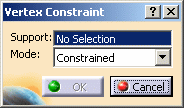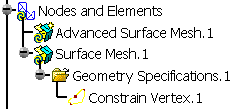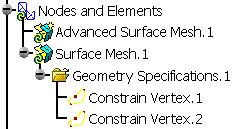This task shows you how to add or remove constraints for a selection of vertices.
-
Open the Sample06.CATAnalysis document from the samples directory.
-
Enter the Surface Mesher workshop.
For more details, refer to Entering the Surface Mesher Workshop.
For a better visualization of constrained vertices, you can
change the color of the part.
To do this:
- Right-click Surface.1 (under Links Manager.1 -> Part1 -> Geometrical Set.1) in the specification tree.
- Select the Properties contextual menu.
- Select the desired Fill Color in the Graphic tab.
- Click OK in the Properties dialog box.
-
Click Add/Remove Constraints on Vertex
 in the Local Specifications toolbar.
in the Local Specifications toolbar.The Vertex Constraint dialog box appears:

- Support: lets you select the vertices on which you
want to add or remove constraints.

Multi-selection of vertices is available.
- Mode: lets you specify if you want to add or remove
constraints on the selected vertices.
- Constrained: lets you add constraints on the selected vertices.
- Unconstrained: lets you remove constraints on the selected vertices.
- Support: lets you select the vertices on which you
want to add or remove constraints.
-
Select one or several constrained vertices as Support.
In this particular example, select a yellow-highlighted vertex as shown below:

-
Select Unconstrained as Mode option in the Vertex Constraint dialog box.
-
Click OK.
The unconstrained vertex is not yellow-highlighted anymore.
A Constrain Vertex.1 object belonging to Geometry Specifications.1 appears in the specification tree under the Surface Mesh.1 mesh part.

-
Click Add/Remove Constraints on Vertex
 in the Local Specifications toolbar.
in the Local Specifications toolbar.The Vertex Constraint dialog box appears.
Note that the vertex you selected in the second step is now blue-highlighted:

-
Select one or several unconstrained vertices as Support.
In this particular example, select a blue-highlighted vertex as shown below:

-
Select Constrained as Mode option in the Vertex Constraint dialog box.
-
Click OK.
The vertex is now yellow-highlighted:

A Constrain Vertex.2 object belonging to Geometry Specifications.1 appears in the specification tree under the Surface Mesh.1 mesh part.

![]()